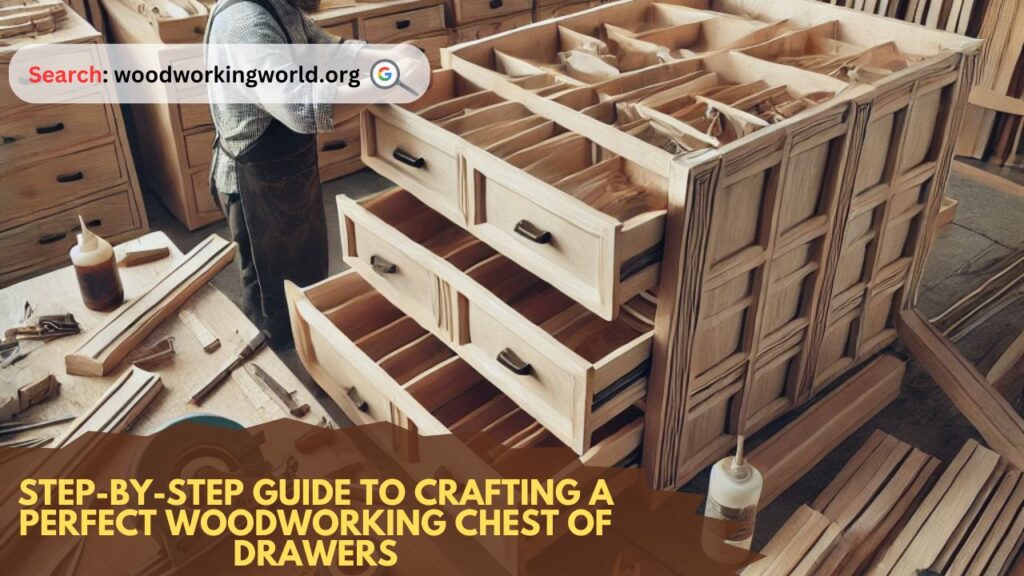Step-by-Step Guide to Crafting a Perfect Woodworking Chest of Drawers
Creating a custom chest of drawers is a rewarding woodworking project that combines practicality with craftsmanship. Whether you’re an experienced woodworker or a beginner looking to hone your skills, this guide will provide detailed instructions on designing, cutting, assembling, and finishing a high-quality chest of drawers.

Step 1: Planning and Design
Before picking up your tools, careful planning and design are essential.
1. Determine the Dimensions
Consider the available space and the storage requirements for your chest of drawers.
- Height: Typically ranges from 30 to 60 inches.
- Width: Can be between 30 to 50 inches.
- Depth: Generally 16 to 20 inches.
Tip: Measure the area where the chest of drawers will be placed and ensure it fits comfortably within your space.
2. Sketch the Design
Draw a simple sketch that includes:
- Number of drawers
- Drawer dimensions
- Overall structure and design features
3. Choose the Wood Type
Select wood based on aesthetics, durability, and budget.
- Hardwood Options: Oak, maple, cherry, and walnut for durability and elegance.
- Softwood Options: Pine and cedar for budget-friendly projects.
Tip: Ensure the wood is properly dried and free from defects.
Start Your Next Project With Teds’ Archive Of 16,000 Plans!
Instant access to all 16,000 woodworking plans with step-by-step details, photos, materials lists and more
Monthly free plans with lifetime membership access – No renewals, recurring fees or other charges


Step 2: Gather Materials and Tools
Materials Needed:
- Lumber for the chest frame and drawer fronts
- Plywood for drawer bottoms and back panels
- Wood glue
- Sandpaper (various grits)
- Wood screws and nails
- Drawer slides
- Finish (stain, paint, or varnish)
Tools Required:
- Table saw
- Miter saw
- Jigsaw
- Drill and bits
- Router with bits
- Clamps
- Measuring tape
- Square
- Sander
Safety Note: Always wear safety goggles, ear protection, and a dust mask while working with power tools.
Step 3: Cutting the Wood
1. Cut the Frame Components
Using a table saw, cut the following pieces:
- Top, bottom, and side panels
- Divider panels (if needed)
Tip: Label each piece to avoid confusion during assembly.
2. Cut the Drawer Components
- Front and back panels
- Side panels
- Bottom panels (plywood)
3. Sand the Pieces
Use a sander with 120-grit sandpaper to smooth all surfaces.
Tip: Sand in the direction of the wood grain to avoid scratches.
Step 4: Assemble the Frame
1. Attach the Side Panels to the Bottom Panel
- Apply wood glue along the edges.
- Clamp the pieces together and secure them with screws.
2. Attach the Top Panel
- Align the top panel with the side panels.
- Secure it with screws and glue.
3. Install Divider Panels (Optional)
If your design includes divider panels, install them now using glue and screws.
Tip: Use a square to ensure all panels are perfectly aligned.
Step 5: Build the Drawers
1. Assemble the Drawer Box
- Apply wood glue to the edges of the side panels.
- Attach the front and back panels.
- Clamp the assembly and secure it with nails or screws.
2. Attach the Drawer Bottom
- Slide the plywood bottom into place.
- Secure it with nails or screws.
3. Install Drawer Slides
- Attach the slides to the sides of the drawer box.
- Install the corresponding slides inside the frame.
Tip: Ensure the slides are level for smooth operation.
Step 6: Attach the Drawer Fronts
- Position the drawer fronts on the drawer boxes.
- Use clamps to hold them in place.
- Drill pilot holes and secure the fronts with screws from the inside.
Tip: Maintain even spacing between drawer fronts for a professional look.
Step 7: Finishing Touches
1. Sand the Entire Chest of Drawers
Use 220-grit sandpaper for a smooth finish.
2. Apply Wood Finish
Choose a finish based on your desired look.
- Stain: Enhances the natural grain of the wood.
- Paint: Provides a bold and colorful appearance.
- Varnish: Adds a protective layer and sheen.
- Apply the finish with a brush or cloth.
- Allow it to dry and apply additional coats as needed.
Tip: Lightly sand between coats for a smooth, professional finish.
3. Attach Hardware
Install drawer pulls or knobs to complete the look.
Step 8: Inspect and Test
- Check that all drawers slide smoothly.
- Ensure the chest is sturdy and free from defects.
- Make any necessary adjustments.
Tip: Place felt pads on the bottom to protect your flooring.
Additional Tips for Success
- Plan Ahead: Double-check your measurements and design before cutting.
- Use Clamps: Clamps are essential for keeping components aligned during assembly.
- Practice Patience: Take your time to ensure accurate cuts and secure joints.
- Safety First: Always follow safety guidelines when using power tools.
Quote: “Good craftsmanship requires both precision and patience.”
Common Mistakes to Avoid
1. Inaccurate Measurements
Always measure twice and cut once to avoid costly errors.
2. Rushing the Finishing Process
Allow adequate drying time for each coat of finish.
3. Poor Alignment
Use a square and clamps to maintain proper alignment.
4. Skipping the Test Fit
Always test fit components before final assembly.
FAQs
1. What type of wood is best for a chest of drawers?
Hardwoods like oak, maple, and walnut are ideal for durability and aesthetics. Pine is a budget-friendly option.
2. Can I build a chest of drawers without power tools?
Yes, it is possible but more time-consuming. Hand saws, chisels, and hand drills can be used.
3. How long does it take to build a chest of drawers?
Depending on your skill level and available time, it can take anywhere from a weekend to a couple of weeks.
4. How do I ensure the drawers slide smoothly?
Install quality drawer slides and ensure they are level during installation.
5. What finish is best for a chest of drawers?
Stain and varnish are popular for showcasing wood grain, while paint offers a bold look.
Video from a woodworking expert

Conclusion
Building a chest of drawers is a satisfying woodworking project that enhances your skills and provides a functional piece of furniture. By following this step-by-step guide and practicing patience, you can craft a beautiful and durable chest of drawers that will stand the test of time. Happy woodworking!